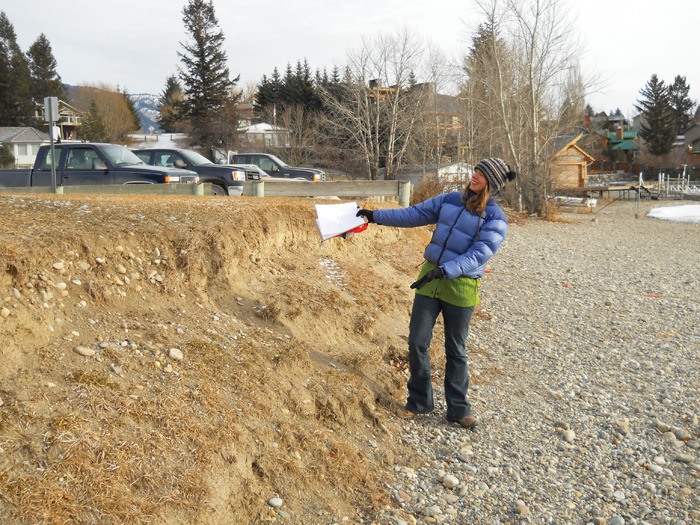In an effort to restore Kinsmen Beach and prevent further erosion, the Lake Windermere Ambassadors (LWA) and the District of Invermere (DOI) are planning a soft shoreline restoration later this month.
For a number of years the shoreline at Kinsmen Beach has been gradually eroding thanks to a combination of human traffic as well as natural causes. Since part of the Lake WIndermere Management Plan is to protect and maintain the shoreline, the LWA and the DOI are planning a “soft” shoreline restoration project, with a goal of breaking ground on the April 22 weekend. There are also concerns that the eroding high bank could be dangerous for children using the beach.
“Over the years the shoreline has been eroded through natural and manmade processes and is reaching a point where rehabilitation is required to prevent further impacts to the aquatic and terrestrial environment,” Rory Hromadnik, Director of Development Services for the District of Invermere said in a release.
“We want this to be a model project for the community because it is such a well-visited beach,” Kirsten Harma, Program Co-ordinator for the Lake Windermere Ambassadors added.
The key term being used here is a “soft” restoration, as opposed to a hard restoration, which Harma says would involve using bulkheads to turn away the waves. Harma says that while the bulkhead route is the more foolproof one, it can actually cause more harm than good, as waves are merely re-directed to another part of the beach where they cause further erosion on someone else’s property. Instead, the plan is to use a combination of rocks, logs and native vegetation, which has the added bonus of creating extra habitats and food sources for any nearby wildlife.
“The rough edges of the rock will deflect waves so as not to create worse erosion further down the beach,” Harma said. “Native plants will provide food and shelter for migratory and resident birds, and will also provide food for fish spawning on the shoreline.”
Furthermore, Harma says that because there is so much traffic on the beach, there are plans to try and funnel visitors to the beach using specific points of access, such as new stairways or paths. With so many different access points to the beach at the moment, Harma says that using these new channels of access will help reduce any man-made damage from visitors climbing up and down the high banks next to the shore.
While the project is set to begin work following Earth Day on April 22 thanks to financial contributions from the DOI, Canadian Wildlife Foundation, Columbia Basin Trust and the Columbia Valley Local Conservation fund among others, there is a need for volunteers to help with the planting of the new vegetation along the shore. As such Harma is asking anyone who is interested in taking part in a bit of a gardening exercise to contact the LWA either by emailing info@lakeambassadors.ca or by calling them at 250-341-6898. In the meantime, Harma asks for patience from beach visitors as the work gets underway.
“It’s going to look like mud and muck for a couple months,” Harma laughed. “We’re just asking that people hold on and visualize (what the beach will look like) a couple of years from now.”
